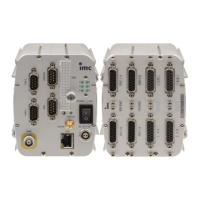© 2018 imc Test & Measurement GmbH
imc C-SERIES - Manual, Version 4 R 3 - 2018-10-19
79Miscellaneous
5.2.4.1 Optical SYNC Adapter: ACC/SYNC-FIBRE
One fundamental feature of all imc measurement devices, whether belonging to the device families imc
CRONOSflex, imc CRONOScompact, imc CRONOS-SL, imc CRONOS-PL, imc SPARTAN, imc BUSDAQ, imc
BUSDAQflex or imc C-SERIES, is their ability to synchronize multiple devices, even of differing models, and
to operate them all in concert. The synchronization is typically accomplished by means of a Master/Slave
process via the electrical SYNC-signal, which terminates on the devices at a BNC socket.
In areas of high electrical interference, or where long-distance signal transmission is needed, the signal
can be conducted via fiber optic cabling with total isolation and no interference. For this purpose, the
externally connectable optical SYNC adapter ACC/SYNC-FIBRE is available.
When this adapter is used, the BNC socket is not, but rather one of the DSUB-9 sockets for the GPS,
DISPLAY or MODEM, which then conducts both the isolated electrical SYNC signal and additionally a
supply voltage which is required by the adapter, as well as supplying directional indication (Master to
Slave).
For this reason, any imc measurement devices used must be remodeled in accommodation to one of the
DSUB-9 sockets. Once either the MODEM or the GPS socket has been remodeled, it is no longer usable
for its original purpose. For the GPS socket, this does not apply. Even parallel operation is possible (via Y-
cable), if the GPS-data are only used for the position data and the adapter is used for the SYNC signal.
For whichever signal (adapter or BNC) is currently connected, both the electrical and the optical mode
can be used, however not both at the same time.
The plug is designed for the extended environmental range. The imc measurement devices used with this
adapter require some modification.
Find here technical details: ACC/SYNC-FIBRE
162

